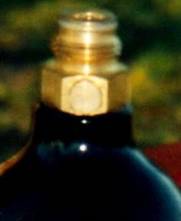
CO2 and CO2 Accessories
By Aaron ďGhostĒ Grubin
CO2 Dynamics
What is CO2? Most of us use it to propel paint toward a target. CO2 is a combination of 2 atoms of Oxygen and one of Carbon. Its molecular structure is simple enough. At normal atmospheric temperatures and pressures, it exists as a clear, colourless odourless gas. When it gets compressed or cooled, things change. When CO2 is pressurized for transport, the molecules get crammed so close together that they turn into a liquid. The pressure that it turns into a liquid depends on the temperature.
When matter heats up, it expands. When it cools, it contracts. When the object contracts the molecules are closer together. So when CO2 is cold, the pressure in the container drops. When it is warm, it increases. There is a temperature however that will cause liquid CO2 to boil and the pressure to increase dramatically. Unfortunately if you leave a tank out in the sun, it can reach the boiling point and the pressure in your tank will increase to dangerous levels. When that happens, there is nothing you can do.
Enter a Swiss physicist named Daniel Bernoulli. Bernoulliís Principle states; ďThe total energy in a system remains constant. If one element of an energy system is increased, another decreases to counter balance it.Ē CO2 in a tank has energy. It has energy in the form of pressure, and temperature. So if one of those elements is changed, the other changes with it. So what does that mean to us?
Since we are reducing the number of molecules of CO2 in the tank when we shoot, the pressure will drop until more vapour can replace the volume that is lost. That process of evaporation takes heat from the remaining volume of gas. We are now introducing another form of energy into the bottle, and that is velocity. The gas must accelerate out of the bottle and into the gun to shoot. As the speed of the gas increases out of the valve, itís temperature drops as well. When the pressure drops, the heat energy contained in that volume of gas that escapes is lost too. The faster we make gas flow out of the tank, the faster the temperature of the gas in the tank drops.
In practical terms, it means that the more we shoot, the more the temperature drops. The more the temperature drops, the less pressure is in the tank. That means that the faster we shoot, the less pressure we get in the gun and that lowers the velocity of the ball leaving the barrel. The graph at this link shows the relationship of temperature and pressure in a CO2 cylinder. http://www.warpig.com/paintball/technical/gasses/co2pv.gif Looking at the chart, the pressure in a full tank at room temperature is about 1000 psi. Compare that to freezing, and the same tank now has a pressure of 500 psi. Left out in the sun on a hot day, and if the tank hits 110 degrees, then itís pressure spikes to almost 1700 psi. So keep those tanks out of the sun.
Three states of matter, one low price. When we are filling our tank to play, the stuff in the tank is mostly liquid under pressure. What flows out is a gas. What happens when the gas flows out quickly? Liquid is forced into the marker under pressure, and we keep shooting. The temperature keeps dropping, and the liquid starts to freeze on internal components. Usually moving ones. This will at first start to cause excessive wear on those components and then if the frozen CO2 keeps building up, blocking the function of the gun and quite possibly damaging components. Frozen CO2 is called Dry Ice.
To discuss how we use compressed gasses to move a paintball at a set speed, then a few basic physical principles must be understood. Some of this will probably cause high school physics flashbacks, but stick with me.
1. Speed = Distance / Time
The speed of an object is a function of how long it takes to cover a distance.
2. Acceleration= change in speed /time or (v2 Ė v1) / time
Acceleration is the rate of change of speed on an object. The longer an object accelerates, the faster it goes, or the faster an object changes its velocity, the greater itís acceleration.
3. Force = mass x acceleration
To generate the same acceleration, with a smaller force, the mass must be decreased.
4. Force = pressure x area
To generate a larger force, pressure or area must be increased.
What is the point of a low-pressure marker? The reason people want low-pressure markers is so that they can use brittle paint. They want to ensure that the ball will break on the target. I can agree with that. Having a ball bounce on someone does suck. So if we use paint that breaks easier, it will mark an opponent better. Hereís the problem. The more fragile the paint is, the easier it will break in your markerís chamber or bolt. The only way to reduce the amount of ball breaks in the chamber is to reduce the force that the ball experiences as it accelerates to its final speed. So to reduce the stress placed on the ball, it is given a gentler ďpushĒ by lower pressure air.
Problem 1. The first problem comes with maintaining your velocity. When the pressure drops, there is less force on the ball for the same distance. That means it doesnít accelerate to the proper speed. What you need to do is to increase the amount of time the lower pressure air is in contact with the ball. You will either have to increase the length of the barrel, or increase the amount of time the valve is open.
Hereís the proof. Force = Pressure x Area. Drop the pressure; keep the same area and the Force drops. Force = Mass x Acceleration. Drop the force applied to a mass and the acceleration suffers.
Problem 2. The drop in pressure in the marker. To accommodate the longer barrel, a larger volume of gas must be used to push the ball down the barrel. Remember, Force = Pressure x Area. Drop the pressure, and you drop the force applied to the ball. So you must use a larger volume of lower pressure air to push the ball down the barrel. This drops the pressure quickly in the marker and causes shoot down. Thatís a loss of velocity when shooting a string of shots in rapid succession. You keep the same point of aim, but the shots keep falling closer and closer.
Problem 3. Reduced gas efficiency. In low-pressure air, there is less potential energy stored in the same volume of gas than in high-pressure air. You need more molecules to get the same job done. This depletes the amount of gas in your tank faster because more CO2 must be pulled to do the same job at a lower pressure.

The first accessory Iím going to talk about is the Burst Disk. I mention it first because it is the only one thatís sole purpose is safety. The burst disk is there to provide a weak point for the tank to fail at in a controlled manner. If you over fill a tank, and leave it out in the sun, it is very possible to dangerously over-pressurize that tank to the point that the walls of the tank themselves will fail and the tank will explode. A burst disk will pop BEFORE the tankís walls break open saving you and your tank. Remember, tank + no disk = bomb. Doubling disks is a dangerous thing to do and should never be done otherwise they canít protect you. Make sure your tank has a burst disk, and if it does rupture, get it replaced by an airsmith.
Most markers donít like to take in liquid CO2. The rapid pressure drop and associated temperature drop can freeze valves and make O-rings brittle. Oils get thick and slow down operations inside and can leave areas of the marker un-protected from wear. Anti siphon tubes are designed to fit inside your tank and draw gas from the top of the tank only. This reduces the possibility of letting liquid CO2 into the gun where it can muck up the whole works. How it works is a tube is placed inside the tank and is bent upward so that it is above the liquid level. It will only work when the gun is straight up and not when it is canted off to the side. Since it has to be set up so that the tube is always pointing up, that means that you can only use that tank on the marker the anti-siphon tube was set up for. One gun, one tank. The advantage to the anti-siphon tube is itís low cost. It is only a special soft metal tube that is bent by hand. Since it involves taking your tank apart, have a qualified airsmith do it. Itís a cheap easy way to keep the bulk of the liquid out of your marker.

A pneumatic valve is a device that allows the passage of a gas through a sealed system on demand. When the valve opens, gas passes through. When the valve closes, the gas is stopped. The amount of gas that passes through a valve depends on the pressure of the gas, the size of the openings, and the duration the valve is open. The valve does not recognize pressure, or flow, it just opens and closes like a door. The door to a room doesnít count how many people go through, it just lets them through. Valves are just controlled by a ram or a striker that opens it. The force of the striker pops the valve open allowing gas to flow through. The force that the striker hits the valve with is what controls how far it opens. Hit it hard and it opens up a lot and lets a larger volume of gas through. Tap it softly and a small volume of gas passes through. In most markers, this is how the speed is controlled. In a low-pressure rig, the size of the holes in the valve must be increased to allow easier passage of the gas. If the ports are too small, then there will not be enough flow to operate the gun.
On-Off valves are tank-mounted valves that allow you to turn on and close off your tank. They have a number of benefits. First of all, it allows you to shut off your marker when not in use as an added safety feature. When removing the tank from the air system adaptor, it can help cut the cost of removing O-rings. You can shut the gas from the tank off, and dry fire your marker to bleed off the pressure inside it and then remove the tank. Since the pressure will have been released, there will be no blow-by as you un-screw the tank. No blow-by means the O-rings stay in good shape for the next time you play. They are reasonably cheap but do require an airsmith to install safely.
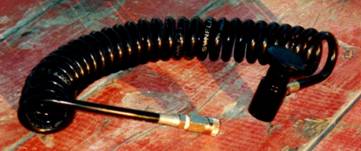
Remote lines are designed to lighten your marker. They allow you to have your tank strapped to another part of your body so your arms donít have to carry it. Most harnesses are designed to accommodate an air tank or CO2 cylinder. As an added benefit, they also allow more room for the CO2 to expand and turn into a vapour before it gets into your marker. They do not prevent liquid from flowing in, but they significantly reduce its chances from occurring. If you are lying down and your marker is below the level of your tank, i.e. on the ground and your tank is on your back, the liquid will flow down hill and into the gun. Especially if the tank is almost full. Another benefit of remote lines is that they give the marker a smaller profile. Less surface area to catch incoming paint. Some users choose to use a gas through stock to brace their markers due to the absence of a tank into the shoulder. Just like the on-off valve, you can turn off the gas at the tank and dry-fire the remaining pressure in the system to save on O-rings. Every little bit helps.
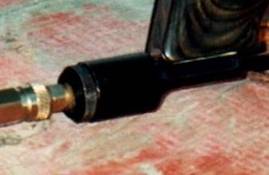
A back bottle is an adaptor that makes the CO2 cylinder sit horizontally back from the gun and acts like a stock to help brace the gun to make accurate shooting easier. It will either come out of the back of the gun, or from the bottom of the pistol grip. Unfortunately, it is more prone to letting liquid into the valve of the marker.
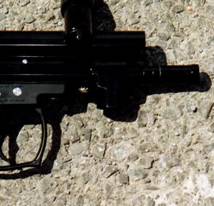
A vertical Bottle Adaptor allows the CO2 cylinder to screw into the body of the marker and hang down. This will definitely keep liquid CO2 out of the valve when held upright, and serves as a large handle on the front. Unfortunately there is nothing to brace into the shoulder unless you can find a stock that you can add on to your marker.
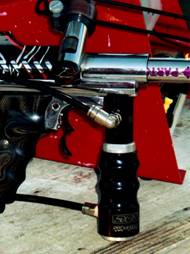
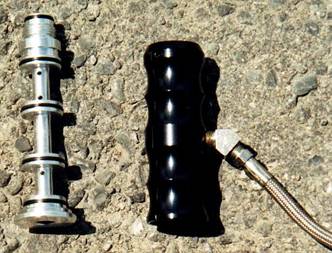
An expansion chamber is a hollow body with a number of chambers designed to allow CO2 to evaporate from a liquid and into a gas. The design of the chambers is also built that liquid canít flow up it under normal circumstances. Since there is a larger volume of vapour upstream of the valve, the total pressure drop inside the system will be less since you have a higher volume of gas to draw upon. This will help reduce shoot-down and keep the velocity more consistent. Expansion chambers are designed to fit on the gun in place of the vertical bottle adaptor so now there is a handle on the front. Combined with a back bottle system, it is exceptionally stable. A good expansion chamber is ergonomically designed to fit into the hand and is contoured for the fingers.
A gas through grip is a hollow chamber that fits on to the front of the marker. It allows gas to pass through into the valve assembly, but is not baffled like an expansion chamber. It is built to hold on to while shooting. It will increase the volume of gas in front of the valve slightly, but liquid can still pass through.
A volumizer is a hollow chamber that stores gas down stream of the valve ready for firing. It gives you a larger volume of gas to draw from when firing which reduces the total pressure drop when firing. This reduces shoot-down and makes the pressure more consistent in the gun. More consistent pressure means more consistent shots. Volumizers are now standard on most new markers from the factory.
A regulator steps the pressure down from a high input pressure to a working pressure into the valve of the marker. The output of the regulator can be controlled and this is how the velocity of the ball is changed. To see how a regulator works with an animated explanation follow this link to Warpig and see for yourself. http://www.warpig.com/paintball/technical/regulators/howtheywork/index.shtml If you plan on running an expansion chamber and a regulator, put the regulator downstream of the expansion chamber to ensure that liquid does not get into the regulator. The regulator only controls pressure, and will not prevent liquid from entering the marker. Especially if the temperature is cold and youíre forcing liquid directly into it.
Iíd like to publicly thank Bill Mills of Warpig for allowing the use of their website in this article. Warpig is an excellent source of information for any player regardless of their skill level. Thanks again Bill.
Aaron ďGhostĒ Grubin